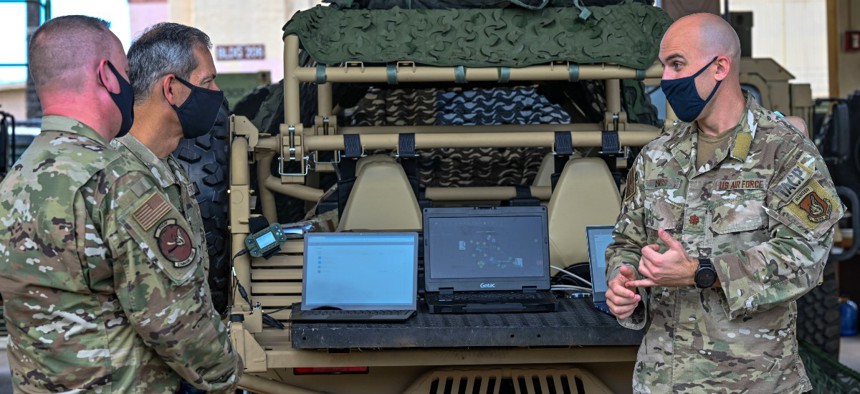
U.S. Air Force Maj. Nathan Rings, 25th Air Support Operations Squadron assistant director of operations,right, briefs U.S. Air Force Chief Master Sgt. David Wolfe, Pacific Air Forces (PACAF) command chief, left, and U.S. Air Force Gen. Ken Wilsbach, PACAF commander, on 25th ASOS joint all-domain command and control capabilities (JADC2) at Wheeler Army Airfield, Hawaii, April 23, 2021. Tech. Sgt. Nick Wilson/U.S. Air Force
Air Force 'Needs to Do More' to Address JADC2 Concerns, GAO Says
The service has made insufficient progress since a 2020 review of its portion of the military-wide tactical network, the Government Accountability Office wrote.
The Air Force has made progress on its planning efforts for the Department of Defense’s initiative to combine information from disparate military domains into one cohesive network, but has not yet delivered any capabilities and is still identifying its future abilities, according to a report from the Government Accountability Office that was released on Friday.
The Pentagon’s ongoing Joint All-Domain Command and Control—or JADC2—effort seeks to streamline interoperability and communication between DOD’s various military assets across air, land, sea and cyberspace. DOD released its JADC2 implementation plan in March 2022, saying at the time that it was “a warfighting necessity” that would allow military personnel “to ‘sense,’ ‘make sense’ and ‘act’ on information across the battle-space quickly using automation, artificial intelligence, predictive analytics and machine learning to deliver informed solutions via a resilient and robust network environment.”
The Air Force’s contribution to JADC2 is the Advanced Battle Management System—or ABMS—which GAO described as “a secure communications network that allows commanders and warfighters to share meaningful data from the field faster.”
GAO’s review of ABMS was requested in a House Armed Services Committee report accompanying the fiscal year 2022 National Defense Authorization Act, as well as by the House Tactical Air and Land Forces Subcommittee, which asked the agency “to provide a review of ABMS and how it will contribute to DOD’s broader goals for JADC2.”
A previous GAO report, released in April 2020, found that the Air Force “started ABMS development without key elements of a business case, such as a cost estimate to inform budget requests,” and recommended that the military branch “develop acquisition and planning documents.”
The latest GAO report—which reviewed the Air Force’s progress since the 2020 evaluation—noted that the military branch has taken a variety of steps in the intervening years to more effectively develop its planning efforts, including creating “a consortium of companies to assist in developing requirements for a network” and establishing “a new leadership structure for ABMS.”
GAO called these efforts “positive steps toward developing ABMS,” but added that the Air Force “has not delivered any capabilities to date and is in the process of identifying future capabilities and when they will be delivered.”
“The Air Force is continuing to evolve and further define key aspects of its ABMS acquisition strategies and management structure, but details on future acquisition efforts are in development,” the report said. The service "needs to do more to fully address" GAO's 2020 recommendations, the report said.
In addition to examining the Air Force’s ABMS effort, GAO noted that DOD is still “in the process of identifying capabilities and challenges” related to its JADC2 implementation. And the agency said that more insights into the Pentagon’s broad initiative will be provided to lawmakers later this year.
GAO noted that a House report accompanying the fiscal year 2023 NDAA included a provision for DOD to report on “the scope, cost and schedule of the overall JADC2 effort,” and that the department is “in the early stages of determining those elements.”
The report said that DOD will provide Congress with an update “between January and March 2023 that addresses progress to date with the JADC2 Campaign Plan and efforts to develop an investment strategy based on near-, mid- [and] long-term JADC2 goals.”




